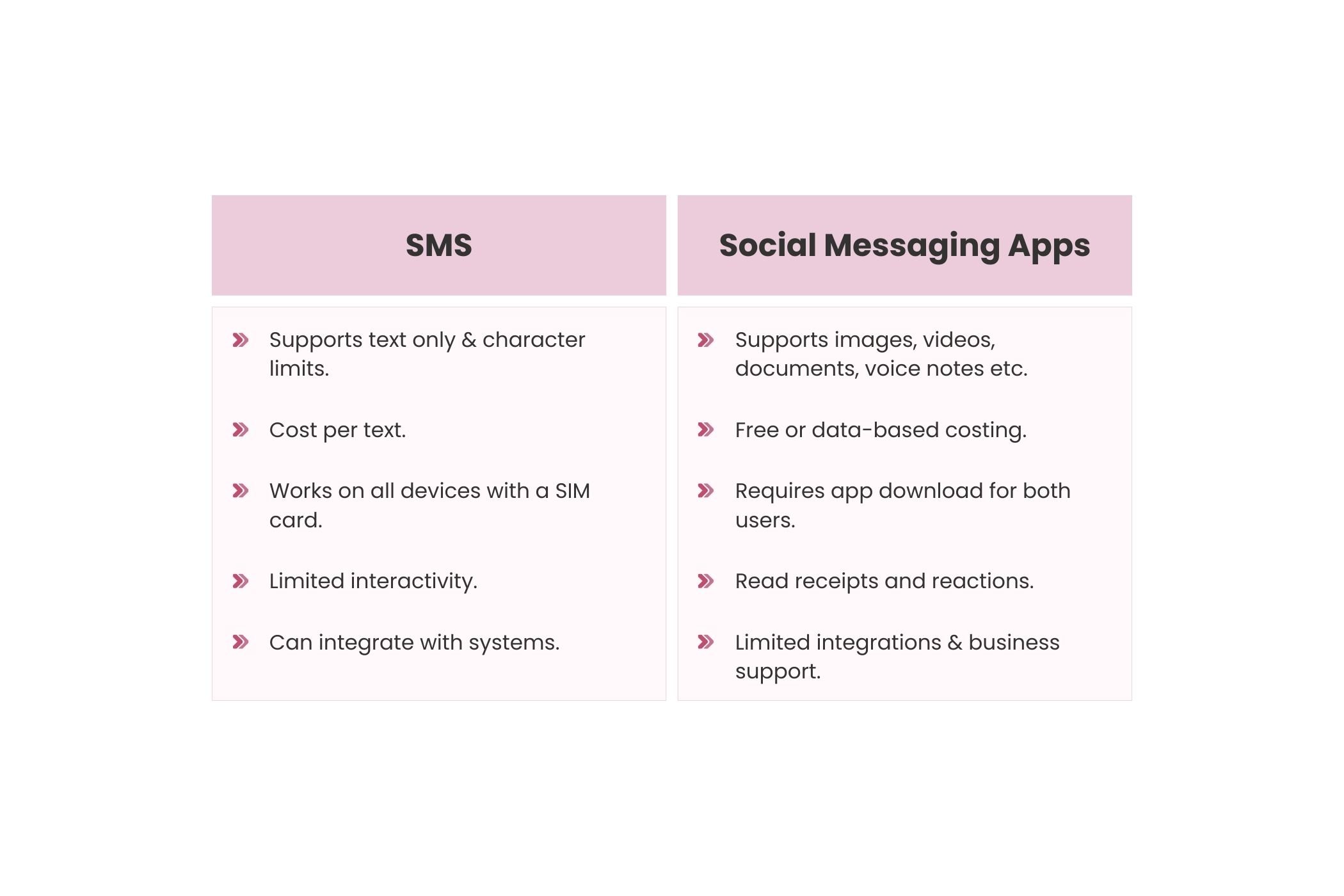What is business social messaging, and is it the right way to go?
In an increasingly connected world, messaging apps have become our default mode of communication - not just between friends and family, but also between businesses and their customers. As businesses look for faster, more engaging ways to communicate than traditional methods like SMS and email, social messaging has begun to make its mark.
But what exactly is social messaging? How is it being used across business practices, and what should you consider before adopting it? Let’s take a look…
What is social messaging?
Social messaging refers to communication via platforms that allow people to send messages over the internet, rather than through mobile networks. These platforms are often described as “over-the-top” (OTT) because they go ‘on top’ of existing networks, and they also allow for the sharing of media rich content such as images, video, gifs, voicenotes and more, without the mobile data costs.
Popular social messaging platforms include:
WhatsApp
Facebook Messenger
iMessage
Telegram.
You may be familiar with these platforms as they are commonly used in our daily lives, but businesses are now adopting them to keep in touch with their customers and stay ahead of the curve as modern customer expectations are ever evolving.
How do social messaging platforms compare against traditional tools like SMS?
While SMS is reliable in most cases, social messaging is often more interactive and engaging. We can see why it is an appealing alternative, particularly for customer-facing teams.
How are businesses adapting using social messaging and why?
As communication expectations evolve away from SMS, many businesses are turning to social messaging platforms to respond to customer queries, share updates, and aid internal communications. In the housebuilding industry particularly, sales teams are using these platforms to share new-build development updates, share property tours, confirm appointments and quickly respond to questions.
And the reasoning is clear. Social platforms allow us to communicate more than just words. With the ability to send multimedia content, the conversation becomes far richer:
Engagement: images and videos capture customer’s attention more effectively than plain text.
Efficiency & Clarity: a demonstrative video or image can resolve a query far quicker than back-and-forth messaging, and visuals can help reduce misunderstandings.
Personalisation: a video can make the conversation feel more human, helping to build trust and strengthen customer relationships.
In many cases, the use of social messaging begins organically: teams will turn to apps that they are already familiar with in their personal lives. We’ve all done it… it’s easy, quick and comes naturally.
However, the use of these platforms raises important questions about brand consistency, professionalism, tracking management and data security.
What are the risks of using popular social messaging channels?
Despite being a great alternative to SMS, phone calls, and email, popular social messaging apps aren’t always built with business needs in mind. There are several things you should consider before adopting these as common practice:
Data security:
Most importantly, messages are often stored on personal devices, outside of company control and with no protection of staff or customer data.No tracking:
It’s hard to look back and monitor conversations across multiple customers and devices. Management also has no visibility or control over the quality of content being sent.No branding:
Messages often come from personal accounts, not a centralised company platform. At most, the message will come from your company name, but will lack branding beyond this point.Inconsistency:
Without management oversight, the tone, accuracy, and information within each message can vary from person to person. Customers will not be receiving the same experience company-wide.Employee turnover:
If someone leaves the company, their communication history may go with them.No business support:
With many of these apps being designed for social use only, they often lack the resources to provide business support on a larger scale.Limited CRM integrations:
Many apps offer little support or understanding of CRM integrations.Training and support:
Many platforms are designed for general social use and lack first & second line business support or training materials.
These risks can affect customer experience, brand consistency, and GDPR compliance, especially across larger teams or complex processes.
Why is there a need for a business friendly alternative?
As more businesses move towards digital communication platforms, there is a need for tools that offer the ease of social messaging, but with features specifically designed for professional use.
This means prioritising data security to protect customer and staff information and meet GDPR compliance requirements. It also involves maintaining brand consistency across every interaction, ensuring communications align with the corporate identity. Additionally, businesses need tracking and analytics to monitor performance, stay consistent, and improve conversion rates.
Perhaps most importantly, a business-friendly solution helps separate work and personal communications, giving employees a professional environment without relying on consumer apps or personal accounts.
Thoughts:
Social messaging has undoubtedly reshaped how people communicate. Ever since the first SMS was sent in 1992, communications have continued to grow and evolve beyond our expectations. Naturally, businesses are taking note. But while platforms like WhatsApp and Messenger offer convenience and familiarity, they come with limitations that businesses can’t afford to overlook.
The future of business social messaging lies in solutions that combine the power of media-rich messaging with the professionalism, control, and security that organisations need to thrive.


